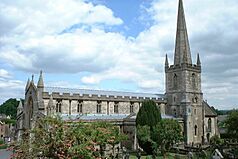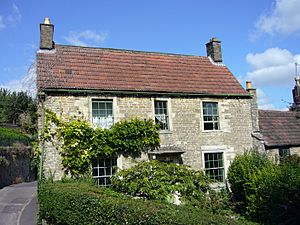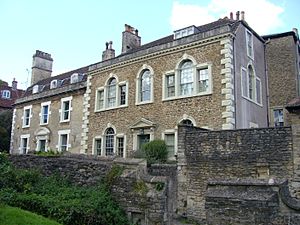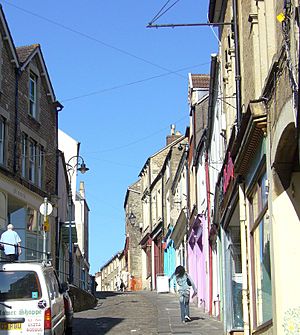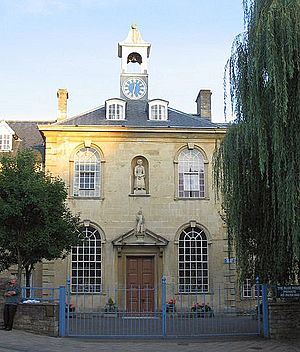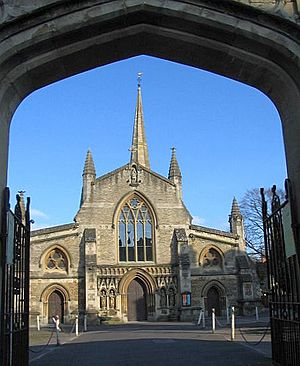Frome facts for kids
Quick facts for kids Frome |
|
|---|---|
|
From the top to bottom-right, Church of St John the Baptist, Market Place, Frome, Bath Street, Catherine Hill
|
|
| Population | 28,559 (2021 Census) |
| OS grid reference | ST775477 |
| Unitary authority |
|
| Ceremonial county | |
| Region | |
| Country | England |
| Sovereign state | United Kingdom |
| Post town | FROME |
| Postcode district | BA11 |
| Dialling code | 01373 |
| Police | Avon and Somerset |
| Fire | Devon and Somerset |
| Ambulance | South Western |
| EU Parliament | South West England |
| UK Parliament |
|
Frome (pronounced FROOM) is a town and parish in Somerset, England. It sits on high ground at the eastern edge of the Mendip Hills. The River Frome flows through the town. Frome is about 13 miles (21 km) south of Bath. In 2021, about 28,559 people lived here.
Frome was once one of the biggest towns in Somerset. It was even larger than Bath between 950 AD and 1650. The town first grew because of its wool and cloth industries. Later, it also became known for metal-working and printing. While these industries have become smaller, Frome still has many historic buildings. Most of its town centre is a protected area.
The town has good road and rail links. It is an important centre for the local area. Frome also offers many cultural and sports activities. These include the yearly Frome Festival and the Frome Museum.
Frome has received praise as a great place to live. In 2014, The Times newspaper called it the "sixth coolest town" in Britain. In 2018 and 2021, The Sunday Times named Frome the best place to live in the South West of England. In 2019, Time Out magazine listed Frome as one of the best weekend trips from London.
Contents
- Frome's Past
- How Frome is Governed
- Health and Care
- Frome's Location and Surroundings
- People of Frome
- Frome's Economy
- Culture and Fun
- Famous Places in Frome
- Churches and Chapels
- Getting Around Frome
- Learning in Frome
- Media
- Sports and Fun Activities
- Famous People from Frome
- Frome's Twin Towns
- Freedom of the Town
- Images for kids
- See also
Frome's Past
There is some proof that Romans lived in the area. A Roman villa was found in the village of Whatley, 3 miles (5 km) west of Frome. In 2010, a huge collection of Roman coins was found near the town. This collection, called the Frome Hoard, had 52,500 coins from the third century AD. They were found buried in a jar. Some of these coins are now on display at the British Museum.
The name Frome comes from an old British word, frāmā. This word means fair, fine, or brisk. It describes how the river flows. The earliest sign of Anglo-Saxons in Frome is a monastery. It was built by St. Aldhelm in 685. Saxon kings used Frome as a base for hunting in Selwood Forest. In 934, an important meeting was held here. This shows Frome was already a significant place. King Eadred, one of the first English Kings, died in Frome in 955.
During the time of the Domesday Book, William the Conqueror owned Frome. It was the main town in the richest area of Somerset. Over time, parts of the land were given to other owners. By the 13th century, a large church (the Abbey at Cirencester) owned much of the land. It made money from the town's markets and trade.
The making of woollen cloth became Frome's main industry in the 15th century. Frome was the only town in Somerset where this industry really grew. Between 1665 and 1725, the town expanded a lot. New homes were built for workers. In the 1720s, writer Daniel Defoe said Frome was "likely to be one of the greatest and wealthiest inland towns in England."
In 1685, the army of the Duke of Monmouth stayed in Frome. This was after a battle at Norton St Philip. Many soldiers left his army while he was there. He was later defeated at the Battle of Sedgemoor.
In the mid-1700s, the wool industry declined. This led to poverty and unrest in Frome. There were riots during this time. By 1791, Frome was not described as grand as it once was. In the early 1800s, a local businessman named Thomas Bunn tried to improve the town. He planned new public buildings and a wide new road, Bath Street.
While wool was still important, other industries started in Frome. A bell-foundry began in 1684. It grew to make parts for the gas industry and employed many people. The J W Singer brass foundry was another big employer. They made bronze statues. One famous statue they made was of Boudica with her daughters. It stands near Westminster Bridge in London. They also made the statue of Lady Justice on top of the Old Bailey in London. Printing was another major industry. The Butler and Tanner printworks started in the mid-1800s. Brewing also provided jobs.
In the 20th century, the old wool industry in Frome ended. The last fabric mill closed in 1965. The town's population fell in the 1930s. But other industries like printing and engineering continued. New factories were built after World War II. This led to the town growing again.
How Frome is Governed
Local Government
Frome is part of the Frome and East Somerset area for national elections. This area chose its first Member of Parliament (MP) in 2024.
Frome did not have its own MP until 1832. In 1934, Mavis Tate became the first female MP for Frome. The town's representation in Parliament changed several times over the years.
Health and Care
Frome has a community hospital run by the National Health Service. It opened in 2008. The closest larger hospital is the Royal United Hospital in Bath.
Frome is known for a special program called the "Frome Model." It started in 2013 to help people who feel lonely. This program was very successful. It reduced emergency hospital visits by 17% over three years. This was at a time when visits increased in other parts of the county. Doctors say it's rare to see such a big drop in emergency admissions. This program has also helped attract new people to the town. Frome is a leader in using non-medical ways to help people's health.
Frome's Location and Surroundings
Frome is built on a type of rock called Forest Marble. This rock formed during the Middle Jurassic period. It has been used to build many local buildings. The land around Frome has other types of rock and soil. The town is built on high ground above the River Frome. The 16th-century town bridge crosses the river in the town centre. The centre is about 65 metres (213 ft) above sea level. The edges of town are higher, between 90 metres (295 ft) and 135 metres (443 ft) high.
The main parts of Frome include Innox Hill, Welshmill, Packsaddle, and Fromefield. Other areas are Stonebridge, Clink, Berkley Down, Easthill, Wallbridge, The Mount, Keyford, and Lower Keyford. Also Marston Gate, The Butts, Critchill, Trinity, and Gould's Ground.
The royal forest of Selwood is no longer there. But the countryside nearby is still very wooded. You can see this on the Longleat and Stourhead estates. To the west of Frome, there are large active limestone quarries. These include Whatley Quarry and Merehead Quarry. There are also old, unused quarries. A special railway line serves the working quarries. It branches off the main line at Frome.
Frome has a mild and wet climate. This is typical for South West England. The average temperature is about 10 °C (50 °F). January is the coldest month, and July and August are the warmest. Frome gets about 1600 hours of sunshine each year. Rainfall is around 800–900 mm (31–35 in) per year. Snow falls for about 8–15 days. The wind usually blows from the south west.
People of Frome
In 1831, Frome had 12,240 people. This number dropped to 11,057 by 1901. It stayed around 11,000 to 12,000 until the 1970s. Since then, the population has grown a lot. By 1991, it had almost doubled to over 23,000. In 2011, the population was 26,203.
In 2001, about 67% of people aged 16 to 74 were working. Only 3% were unemployed. About 68% of workers were in service industries. The rest worked in manufacturing. Most homes (75%) were owned by the people living in them.
Frome's Economy
The metal-working and printing industries are still in Frome, but they are smaller now. Singers still has a presence, and Butler Tanner and Dennis (a printing company) is also here.
Almost half of the people who work in Frome travel outside the town for their jobs. They go to places like Bath, Bristol, or Westbury. About 2,700 people travel into Frome for work.
Frome town centre has many independent shops. There are also a few chain stores. The shops mainly serve the local people. They sell food, clothes, health and beauty items, and some electrical goods. There are two large supermarkets on the edge of town. Three smaller ones are in the town centre.
Markets are held on Wednesdays and Saturdays in the town centre. Some are in the Market Yard car park. Others are in the Cheese and Grain, an old farm warehouse. From March to December, a special street market called 'The Independent' is held on the first Sunday of each month. The main street is closed to cars. It fills with over 150 stalls selling antiques, crafts, food, and vintage clothes. Frome was given "Fairtrade Town" status in 2003.
Plans for Frome's future include building 2,500–2,600 new homes. They also plan more job and office spaces. There will be a new secondary school and two new primary schools. The town centre will be updated. These plans aim to bring more shops and fun activities to Frome.
Many new homes have been built in Frome. Some are on old industrial sites. There are also plans to redevelop an area called Saxonvale. This will include homes, shops, and a 'cultural quarter' for artists.
Culture and Fun
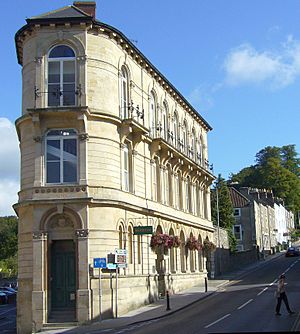
Frome has a lively arts scene. The biggest event is the annual ten-day Frome Festival in July. It has over 160 events around the town. Many artists in Frome open their studios to the public during the festival. There is also a Children's Festival.
Other regular events include Window Wonderland in March and Apple Day in October. There are also Fireworks in November and Light the Night in late November. The Carnival in September is part of a larger regional circuit. A national Town Crier festival is held every June. It is the largest in Britain, with 25 town criers.
Frome has two theatres. The Memorial Theatre was built in 1924 to remember those lost in World War I. The Merlin Theatre is part of the Frome Community College campus. The Cheese and Grain is a former warehouse. It was turned into a market and concert hall in 1997. It can hold up to 800 people and hosts many pop concerts.
Frome's only cinema, the Westway, is in Cork Street. It closed for a while but reopened in 2017 after being renovated. There is also an arts centre called The Black Swan.
The Frome & District Agricultural Society holds an annual Agricultural & Cheese Show in September. This event used to be held at the Showground in Fromefield. Now it is held outside of town. Early markets in Frome were known for selling cheese. The Agricultural Society started in 1861.
The Frome Society for Local Study was founded in 1958. It helps people learn about Frome's history. It also works to protect historic buildings and records. The Frome Museum has important items from Singer's bronze foundry. It also shows local history.
Frome has two local newspapers: the Frome & Somerset Standard and the Frome Times. FromeFM is a local radio station run by volunteers. It broadcasts 24 hours a day on 96.6 FM.
Frome's Cheap Street was used as a filming location for the BBC TV show The Fall and Rise of Reginald Perrin. Frome has also been a backdrop for historical dramas like Poldark. Catherine Hill was the setting for the 2016 short film Lucky Chicken.
Frome has many cafes and restaurants.
Famous Places in Frome
The older parts of Frome, like Sheppard's Barton and Catherine Hill, are very pretty. They have many small houses from the late 1600s and 1700s. The Trinity area was built between 1660 and 1756. It is a rare example of early industrial housing. More than 300 houses were built in a planned grid pattern. Some were torn down in the 1960s. But the rest were saved and restored. The former Selwood Printing Works is also in this area. Stony Street is a steep, cobbled road that goes up from the town centre.
Cheap Street has buildings from the 1500s and 1600s. A stream runs down the middle of the street. It comes from a spring at St John's Church. Cheap Street has never been used by cars. Its layout is very old.
The bridge over the River Frome in the town centre was rebuilt in 1821. Houses were built along one side of it. It is one of only three bridges in England that have buildings on them. The others are Pulteney Bridge in Bath and the High Bridge in Lincoln. The Tourist Information Centre is in a circular building. It was once a dye-house. It was restored in 1994. In recent years, many of Frome's historic buildings have been restored.
Frome has 370 listed buildings. This is the most in Somerset, apart from Bath. Three of these buildings are Grade I listed, meaning they are very important. The Blue House is next to the town bridge. It used to be a school and almshouse. It was built in 1726. It provided homes for twenty widows and schooling for twenty boys. The front of the building has statues of a man and a woman. They show the building's two purposes. Today, it provides homes for elderly residents.
Rook Lane Chapel was a nonconformist church built between 1705 and 1707. It was a large and impressive building for its time. The chapel stopped being used in 1968. It was later restored and converted. Now, the ground floor is a community hall and arts centre. The upper floor is used as offices.
Frome is said to have tunnels under its old streets. Some entrances can be seen above ground. Others are in the cellars of shops and houses. No one knows their full purpose or how far they go. Local groups have explored them.
Merchants Barton is a passageway in the Saxonvale area. It dates back to around 1785. It was used by workers of the textile and silk factories that were in Saxonvale. When these factories closed, other companies moved in. Workers, mostly women, walked along Merchants Barton. They were known as the 'Bussmann Girls'.
The Old Town Wall is another ancient structure in Frome. It runs from Bath Street into Saxonvale. The facade of the Old Slaughterhouse is also important. It shows how old buildings in the area were made.
Churches and Chapels
The parish church of St John the Baptist was built between the late 1100s and early 1400s. It replaced an older Saxon building from 685 AD. Major restoration work happened in the 1860s. This included building the Via Crucis, which is special for an Anglican church. Outside the church is the tomb of Bishop Thomas Ken. The church tower has eight bells.
Other Anglican churches in Frome include Christ Church, built in 1818. Holy Trinity was built in 1837–38. It is unusual because its altar is at the west end. St Mary's at Innox Hill was built in 1863.
The Roman Catholic church in Frome, St Catharine's, was built in 1967 and 1968. Rook Lane Chapel was a nonconformist chapel used from 1707 to 1968. In 1773, a new Zion Congregational Church was started. This building was replaced in 1810. A Quaker Meeting House existed from 1675 to 1856. The original building was replaced around 1730. It later became a school and library.
Baptists have worshipped in Frome since 1669. They had two churches. One was built in 1708 and replaced in 1850. The other was built in 1711 and replaced in 1813. The Methodist church, built in 1812, is still in use. Sun Street Chapel was built by the Primitive Methodists in 1834. It is now a Community Centre. There is another Methodist church on Portway, built in 1910. A cemetery for nonconformists was founded in 1851.
Getting Around Frome
Frome has a train station on the Heart of Wessex Line. Frome station opened in 1850. It is one of Britain's oldest working stations. You can take direct trains to Bristol, Exeter, Weymouth, and London. A freight line branches off through the town. It serves the quarries on the Mendip Hills. Part of an old railway line is now National Cycle Route 24, called the Colliers Way.
Frome has several bus routes. The busiest is the D2/D2x service to Bath. Other bus companies also run services in Frome.
The A361 bypasses the town on the south and east sides. The A362 goes through the town centre. Frome is about 26 miles (41 km) southeast of the M4 motorway.
The Town Council has a special officer to help with transport. They support things like a public car club. Electric car charging points are available around town.
Learning in Frome
Frome has thirteen first schools for children aged 4 to 9. These include Berkley Church of England First School and St Louis Catholic Primary School.
There are two middle schools for ages 9 to 13: Oakfield Academy and Selwood Anglican/Methodist Middle School. The main college is Frome Community College. It provides education for ages 13 to 18. It specializes in media arts. Critchill School is a special school for students with special educational needs. Farleigh Further Education College helps students aged 16 to 25 with Asperger syndrome.
Frome does not have universities. The closest is the University of Bath. Somerset Skills & Learning offers apprenticeships and training in Frome.
Media
Local news and TV shows come from BBC West and ITV West Country.
Local radio stations include BBC Radio Somerset and Heart West. FromeFM is a community radio station that broadcasts on 96.6 FM.
The local newspaper is the Frome Times.
Sports and Fun Activities
The Leisure Centre offers many activities. These include swimming, indoor bowls, squash, and a gym. It opened in 1974 and was updated in 2015-2016. There are also water sports clubs like the Frome and Warminster Dive Club. An inland diving centre is near Frome at Vobster.
Victoria Park has sports like bowls, tennis, and a skateboard ramp. It also has a children's playground. The Millennium Green has walking paths and a picnic area. The town is at one end of the Mendip Way. This is a 80-kilometre (50 mi) long walking path across the Mendip Hills.
Badgers Hill is the home of Frome Town F.C., the local football club. They were promoted to the Southern Football League in 2009. The Frome Town ladies' team also plays there. The club has youth teams for players from under 6 to under 18. They also offer a football academy program.
Frome Cricket Club plays at the Agricultural Showgrounds. The club started in 1925. Famous players like Colin Dredge and Mark Harmon have played for Frome.
Frome Rugby Football Club started in 1883. It has four senior teams and many mini and junior teams. The First XV plays in the Wadworth 6X Southern Counties South league.
Two cycling clubs operate in Frome: the Frome CTC and the Frome & District Wheelers. You can also rent electric bikes.
The Frome Cobble Wobble was a bicycle hill climb race. It was first held in 2009 to celebrate the Tour of Britain starting in Frome. The last race was in 2012.
Frome has set Guinness World Records. In 2018, 678 rowers set a record for the most people to row 500m each in a 24-hour relay. In 2019, a new record was set for the most players in an eight-hour game of skittles, with 593 people. Both events raised money for a local charity.
The Frome Half Marathon has taken place every year since 2001. It also includes 10k, 5k, and Family Fun Runs.
Frome is a "Walkers are Welcome" town. This means it is great for walking. There are many walks and guides available. Guided walks on different topics are also available online. The East Mendip Way goes through Frome. It gives access to a long walking path across the Mendip Hills.
Famous People from Frome
- Benjamin Baker (1840), who built the Forth Bridge, was born in Frome.
- Jenson Button (1980), a Formula One racing driver and 2009 world champion, was born in Frome. A street and a bridge are named after him. He was given the "freedom of the town" in 2010.
- Cara Dillon, an Irish folk singer, has lived in Frome since 2002.
- Colin Dredge (1954), a cricketer, was born in Frome.
- Edward Cockey (1781–1860), who started an iron foundry and brought gas to Frome, lived and died here.
- King Eadred (923–955), an English king, died in Frome in 955.
- Alfred "Pee Wee" Ellis (1941–2021), a saxophonist and composer, lived in Frome.
- Anna Friel, an actress, lives in Frome.
- Wilfred Dolby Fuller (1893–1947), who received the Victoria Cross, worked and died in Frome.
- Danny Goffey, the drummer for the band Supergrass, lives in Frome.
- Guy Green (1913), a film director and cinematographer who won an Oscar, was born in Frome.
- Alice Seeley Harris (1870), a pioneering photographer and human rights activist, was born in Frome.
- Charlie Higson (1958), from The Fast Show, was born in Frome.
- Simon King, a naturalist and broadcaster, has a business in town.
- Lois Maxwell, who played Miss Moneypenny in the James Bond films, lived in Frome from 1994 to 2001.
- Sir Charles Oatley (1904), who helped develop the scanning electron microscope, was born in Frome.
- Anthony Powell, an author, died in Frome in 2000.
- William Henry "Billy" Reed (1875), a violinist and composer, was born in Frome.
- Christina Rossetti (poet), helped run a school in Frome in 1853–1854.
- Elizabeth Singer Rowe (poet), was from Frome.
- John Webb Singer (1819–1904), a bronze art founder, was born, worked, and died in Frome.
- Emma Sheppard (1813–1871), a writer and reformer, lived and was buried in Frome.
- Mavis Tate, a campaigner for women's rights, was Frome's only female MP from 1937 to 1945.
- Kerry Wilkinson, an author, went to school in Frome.
Frome's Twin Towns
Frome has three twin towns:
- Château-Gontier in France
- Murrhardt in Germany
- Rabka-Zdrój in Poland
Freedom of the Town
The following person has received the special honour of "Freedom of the Town" of Frome:
- Jenson Button: 4 May 2010.
Images for kids
-
"The Chapel of St Ffraw" (Welsh name for Frome), from A Tour in Wales by Thomas Pennant (1726-1798) that chronicle the three journeys he made through Wales between 1773 and 1776.
See also
 In Spanish: Frome para niños
In Spanish: Frome para niños


